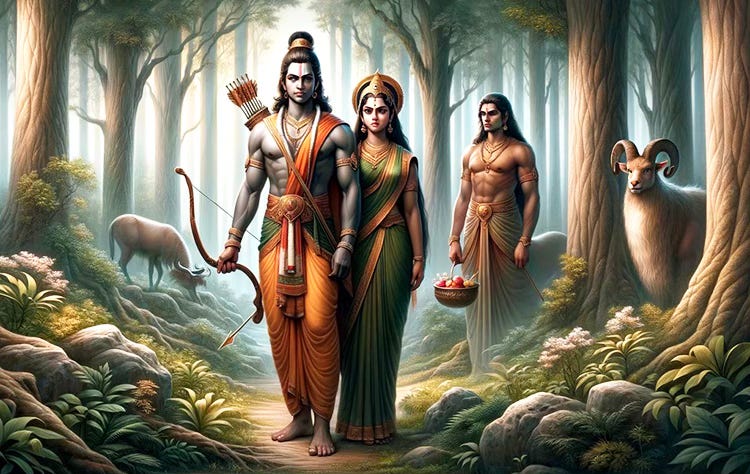The Valmiki Ramayana is one of the most revered texts of Hinduism. It is an epic that transcends time and culture. Composed by the sage Valmiki, this ancient Sanskrit epic narrates the life and adventures of Shri Rama, an incarnation of the deity Vishnu. Often considered the adi kavya or "first poem," the Ramayana holds a prominent place in the hearts of millions, shaping moral values and cultural identity across generations. Importantly, Valmiki’s Ramayana is regarded as the original and most authentic version of this epic, classified as itihasa, a historical narrative that is deeply intertwined with the culture and spirituality of India.
The Structure of Valmiki’s Ramayana
The Valmiki Ramayana is divided into seven Kandas (books):
Bala Kanda: This section introduces Rama’s divine birth, his childhood, and the early days of his life in Ayodhya.
Ayodhya Kanda: It narrates the political intrigue leading to Rama’s exile and the emotional turmoil of his family.
Aranya Kanda: This Kanda follows Rama and his wife Sita during their time in the forest, detailing their encounters with sages and demons.
Kishkindha Kanda: The story unfolds in the kingdom of Kishkindha, where Rama befriends Hanuman and the vanaras in his quest to rescue Sita.
Sundara Kanda: One of the most celebrated sections, it recounts Hanuman’s journey to Lanka and his courageous efforts to find and communicate with Sita.
Yuddha kanda: This Kanda describes the great battle between Rama and Ravana, the demon king of Lanka, culminating in Sita’s rescue.
Uttara Kanda: The final book addresses the aftermath of the war, including Rama’s return to Ayodhya, his coronation, and the trials faced by Sita.
Lessons of the Ramayana
The Valmiki Ramayana is not just a tale of adventure; it embodies profound philosophical and moral lessons. Some of the prominent themes include:
Dharma: The Ramayana emphasises the importance of duty and righteousness in both personal and social contexts. Rama’s unwavering commitment to his dharma as a son, husband, and king is a central motif throughout the epic.
Devotion and Loyalty: Characters like Sita, Hanuman, and Lakshmana exemplify unwavering loyalty and devotion. Their sacrifices and dedication serve as ideals for devotion in relationships.
Good vs. Evil: The epic portrays the eternal struggle between good and evil, personified by Rama and Ravana. This conflict illustrates the ultimate triumph of virtue over vice.
Compassion and Forgiveness: The narrative emphasises compassion, showcasing how love and forgiveness can heal and restore relationships even in the face of betrayal and adversity
Cultural Impact
The Valmiki Ramayana has profoundly influenced Indian culture and tradition. Its characters and stories are embedded in various art forms, including dance, theatre, and literature. The epic is celebrated through Rama Navami, the festival marking the birth of Lord Rama, and Vijay Dashami (Dashera), which commemorates his victory over Ravana.
In addition to its religious significance, the Ramayana has inspired countless adaptations and retellings in various languages and cultures, including the Kamba Ramayanam in Tamil and the Ramcharitamanas by Tulsidas in Hindi. However, Valmiki’s Ramayana remains the most authentic version, firmly rooted in the historical and spiritual fabric of India. The story continues to resonate with audiences around the world, serving as a source of inspiration for moral conduct, heroism, and devotion.
A New Retelling
As someone who is passionate about the Hindu epics, I am currently undertaking the challenging and rewarding project of writing a retelling of the Valmiki Ramayana in English. This task has proven to be both tiring and demanding, but I am committed to making the essence of this timeless itihasa accessible to a wide audience.
Translating and adapting such a work is no small endeavour, especially when you aim to preserve the original meanings and cultural nuances while presenting the tale in a modern context. Regardlesss of this, I am excited about the progress we are making and the journey ahead…
So, What Now?
The Valmiki Ramayana is more than just a narrative; it is a treasure trove of wisdom and ethical guidance. As we delve into its verses and explore its timeless teachings, we uncover valuable insights into the human condition, relationships, and the pursuit of righteousness. This epic remains a cornerstone of Indian heritage and spirituality, inviting readers and listeners alike to reflect on their own paths in life.
I am thrilled to share that my retelling of the Valmiki Ramayana is now in its final stages of completion. It has been an immensely rewarding but challenging journey, striving to remain true to the spirit of the original while making it accessible to contemporary audiences.
As I near completion of this magnificent and humbling project, I ask for your prayers and support for a successful launch soon. With your well-wishes, I hope to share this incredible story with the world soon and hope that you will join and support me.
Stay tuned for updates and join me in celebrating this timeless epic’s journey towards a new retelling true to its original.
Prayers and Love,
Vinay





💐 Jai Swaminarayan 💐
Jay Swaminarayan